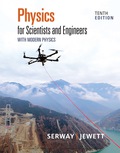
Concept explainers
(a)
The Earth’s orbital speed at aphelion.
(a)
Answer to Problem 39AP
The Earth’s orbital speed at aphelion is
Explanation of Solution
The maximum distance from the Earth to the Sun is
By the conservation of
Here,
The angular momentum at perihelion is given as,
Here,
The angular momentum at aphelion is given as,
Here,
Substitute
Substitute
Conclusion:
Therefore, the Earth’s orbital speed at aphelion is
(b)
The kinetic and potential energy of the Earth-Sun system at perihelion.
(b)
Answer to Problem 39AP
The kinetic of the Earth-Sun system at perihelion is
Explanation of Solution
Formula to calculate the kinetic energy of the Earth-Sun system at perihelion is,
Substitute
Formula to calculate the potential energy of the Earth-Sun system at perihelion is,
Here,
Substitute
Conclusion:
Therefore, the potential energy of the Earth-Sun system at perihelion is
(c)
The kinetic and potential energy of the Earth-Sun system at aphelion.
(c)
Answer to Problem 39AP
The kinetic of the Earth-Sun system at aphelion is
Explanation of Solution
Formula to calculate the kinetic energy of the Earth-Sun system at aphelion is,
Substitute
Formula to calculate the potential energy of the Earth-Sun system at aphelion is,
Here,
Substitute
Conclusion:
Therefore, the potential energy of the Earth-Sun system at aphelion is
(d)
Whether the total energy of the Earth-Sun system constant.
(d)
Answer to Problem 39AP
Yes, the total energy of the Earth-Sun system is remains constant.
Explanation of Solution
Formula to calculate the total energy of the Earth-Sun system at aphelion is,
Here,
Substitute
Formula to calculate the total energy of the Earth-Sun system at perihelion is,
Here,
Substitute
Mathematically proved, the sum of kinetic energy and potential energy of the Earth–Sun system at perihelion is identical to the sum of kinetic energy and potential energy of the Earth–Sun system at aphelion. So the total energy of the Earth-Sun system is constant.
Conclusion:
Therefore, yes, the total energy of the Earth-Sun system remains constant.
Want to see more full solutions like this?
Chapter 13 Solutions
EBK PHYSICS FOR SCIENTISTS AND ENGINEER
- A 0.850-m-long metal bar is pulled to the right at a steady 5.0 m/s perpendicular to a uniform, 0.650-T magnetic field. The bar rides on parallel metal rails connected through a 25-Ω, resistor (Figure 1), so the apparatus makes a complete circuit. Ignore the resistance of the bar and the rails. Please explain how to find the direction of the induced current.arrow_forwardFor each of the actions depicted, determine the direction (right, left, or zero) of the current induced to flow through the resistor in the circuit containing the secondary coil. The coils are wrapped around a plastic core. Immediately after the switch is closed, as shown in the figure, (Figure 1) in which direction does the current flow through the resistor? If the switch is then opened, as shown in the figure, in which direction does the current flow through the resistor? I have the answers to the question, but would like to understand the logic behind the answers. Please show steps.arrow_forwardWhen violet light of wavelength 415 nm falls on a single slit, it creates a central diffraction peak that is 8.60 cm wide on a screen that is 2.80 m away. Part A How wide is the slit? ΟΙ ΑΣΦ ? D= 2.7.10-8 Submit Previous Answers Request Answer × Incorrect; Try Again; 8 attempts remaining marrow_forward
- Two complex values are z1=8 + 8i, z2=15 + 7 i. z1∗ and z2∗ are the complex conjugate values. Any complex value can be expessed in the form of a+bi=reiθ. Find θ for (z1-z∗2)/z1+z2∗. Find r and θ for (z1−z2∗)z1z2∗ Please show all stepsarrow_forwardCalculate the center of mass of the hollow cone shown below. Clearly specify the origin and the coordinate system you are using. Z r Y h Xarrow_forward12. If all three collisions in the figure below are totally inelastic, which will cause more damage? (think about which collision has a larger amount of kinetic energy dissipated/lost to the environment? I m II III A. I B. II C. III m m v brick wall ע ע 0.5v 2v 0.5m D. I and II E. II and III F. I and III G. I, II and III (all of them) 2marrow_forward
- 11. If all three collisions in the figure below are totally inelastic, which brings the car of mass (m) on the left to a halt? I m II III m m ע ע ע brick wall 0.5v 2m 2v 0.5m A. I B. II C. III D. I and II E. II and III F. I and III G. I, II and III (all of them)arrow_forwardHow can you tell which vowel is being produced here ( “ee,” “ah,” or “oo”)? Also, how would you be able to tell for the other vowels?arrow_forwardYou want to fabricate a soft microfluidic chip like the one below. How would you go about fabricating this chip knowing that you are targeting a channel with a square cross-sectional profile of 200 μm by 200 μm. What materials and steps would you use and why? Disregard the process to form the inlet and outlet. Square Cross Sectionarrow_forward
 Principles of Physics: A Calculus-Based TextPhysicsISBN:9781133104261Author:Raymond A. Serway, John W. JewettPublisher:Cengage Learning
Principles of Physics: A Calculus-Based TextPhysicsISBN:9781133104261Author:Raymond A. Serway, John W. JewettPublisher:Cengage Learning Physics for Scientists and Engineers: Foundations...PhysicsISBN:9781133939146Author:Katz, Debora M.Publisher:Cengage Learning
Physics for Scientists and Engineers: Foundations...PhysicsISBN:9781133939146Author:Katz, Debora M.Publisher:Cengage Learning Classical Dynamics of Particles and SystemsPhysicsISBN:9780534408961Author:Stephen T. Thornton, Jerry B. MarionPublisher:Cengage Learning
Classical Dynamics of Particles and SystemsPhysicsISBN:9780534408961Author:Stephen T. Thornton, Jerry B. MarionPublisher:Cengage Learning University Physics Volume 1PhysicsISBN:9781938168277Author:William Moebs, Samuel J. Ling, Jeff SannyPublisher:OpenStax - Rice University
University Physics Volume 1PhysicsISBN:9781938168277Author:William Moebs, Samuel J. Ling, Jeff SannyPublisher:OpenStax - Rice University Physics for Scientists and Engineers, Technology ...PhysicsISBN:9781305116399Author:Raymond A. Serway, John W. JewettPublisher:Cengage Learning
Physics for Scientists and Engineers, Technology ...PhysicsISBN:9781305116399Author:Raymond A. Serway, John W. JewettPublisher:Cengage Learning College PhysicsPhysicsISBN:9781305952300Author:Raymond A. Serway, Chris VuillePublisher:Cengage Learning
College PhysicsPhysicsISBN:9781305952300Author:Raymond A. Serway, Chris VuillePublisher:Cengage Learning





